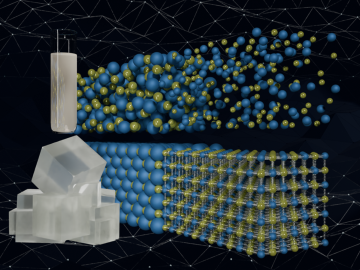
Filter News
Area of Research
- Advanced Manufacturing (7)
- Biology and Environment (86)
- Biology and Soft Matter (1)
- Building Technologies (2)
- Computational Biology (1)
- Computational Engineering (2)
- Computer Science (8)
- Electricity and Smart Grid (3)
- Energy Science (133)
- Energy Sciences (1)
- Functional Materials for Energy (1)
- Fusion and Fission (25)
- Fusion Energy (15)
- Isotopes (1)
- Materials (54)
- Materials for Computing (10)
- Mathematics (1)
- National Security (39)
- Neutron Science (18)
- Nuclear Science and Technology (11)
- Quantum information Science (4)
- Sensors and Controls (1)
- Supercomputing (56)
News Topics
- (-) Coronavirus (48)
- (-) Cybersecurity (35)
- (-) Fusion (67)
- (-) Grid (74)
- (-) Machine Learning (68)
- (-) Microscopy (56)
- 3-D Printing/Advanced Manufacturing (147)
- Advanced Reactors (40)
- Artificial Intelligence (131)
- Big Data (79)
- Bioenergy (112)
- Biology (128)
- Biomedical (73)
- Biotechnology (39)
- Buildings (74)
- Chemical Sciences (86)
- Clean Water (33)
- Composites (35)
- Computer Science (226)
- Critical Materials (29)
- Education (5)
- Element Discovery (1)
- Emergency (4)
- Energy Storage (114)
- Environment (218)
- Exascale Computing (67)
- Fossil Energy (8)
- Frontier (64)
- High-Performance Computing (130)
- Hydropower (12)
- Irradiation (3)
- Isotopes (62)
- ITER (9)
- Materials (157)
- Materials Science (158)
- Mathematics (12)
- Mercury (12)
- Microelectronics (4)
- Molten Salt (10)
- Nanotechnology (64)
- National Security (86)
- Neutron Science (171)
- Nuclear Energy (122)
- Partnerships (68)
- Physics (69)
- Polymers (35)
- Quantum Computing (53)
- Quantum Science (93)
- Security (31)
- Simulation (65)
- Software (1)
- Space Exploration (26)
- Statistics (4)
- Summit (71)
- Transportation (103)
Media Contacts

Scientists have developed a new machine learning approach that accurately predicted critical and difficult-to-compute properties of molten salts, materials with diverse nuclear energy applications.

As the focus on energy resiliency and competitiveness increases, the development of advanced materials for next-generation, commercial fusion reactors is gaining attention. A recent paper examines a promising candidate for these reactors: ultra-high-temperature ceramics, or UHTCs.
Researchers at Oak Ridge National Laboratory have developed a modeling method that uses machine learning to accurately simulate electric grid behavior while protecting proprietary equipment details. The approach overcomes a key barrier to accurate grid modeling, helping utilities plan for future demand and prevent blackouts.
Robert “Bob” Hettich, an ORNL Corporate Fellow, is a pioneer in using mass spectrometry to uncover how microbes interact within complex environments and influence larger systems like plants and humans. A founder of the field of metaproteomics, he leads research that supports bioenergy, environmental resilience and health through advanced protein analysis.
ORNL, the Tennessee Valley Authority and the Tennessee Department of Economic and Community Development were recognized by the Federal Laboratory Consortium, or FLC, for their efforts to develop Tennessee as a national leader in fusion energy.
Daniel Jacobson, distinguished research scientist in the Biosciences Division at ORNL, has been elected a Fellow of the American Institute for Medical and Biological Engineering, or AIMBE, for his achievements in computational biology.
Troy Carter, director of the Fusion Energy Division at Oak Ridge National Laboratory, leads efforts to make fusion energy a reality, overseeing key projects like MPEX and fostering public-private collaborations in fusion research.
Dave Weston studies how microorganisms influence plant health and stress tolerance, using the Advanced Plant Phenotyping Laboratory to accelerate research on plant-microbe interactions and develop resilient crops for advanced fuels, chemicals and

US ITER has completed delivery of all components for the support structure of the central solenoid, the 60-foot-tall superconducting magnet that is the “heart” of the ITER fusion machine.

During his first visit to Oak Ridge National Laboratory, Energy Secretary Chris Wright compared the urgency of the Lab’s World War II beginnings to today’s global race to lead in artificial intelligence, calling for a “Manhattan Project 2.”


